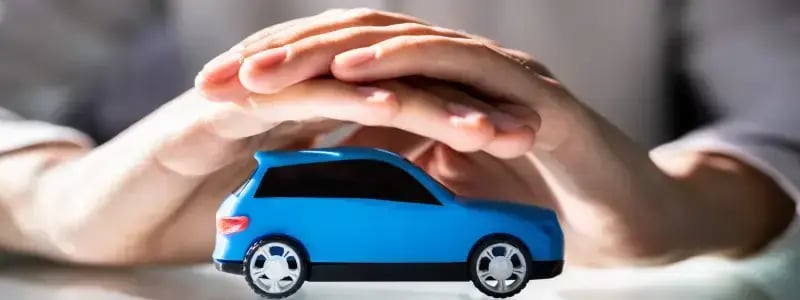Should I Buy A Cat S Car?
by Will Marsh on Jun 20, 2025 2:40:51 PM
Key Summary
Cat S cars have suffered structural damage, which can be any of the following:
- Car chassis damage.
- Suspension damage.
- Severe roof damage.
- Damage to floor pan.
- Severe front or rear-end collision.
Cat S cars are more expensive to insure, as an issue is more likely to come back if a car has suffered structural damage.
Cat S cars can be a cheaper way to buy, but they come with higher insurance costs, reduced resale value, and potential safety risks if repairs weren’t completed correctly. Whether a Cat S car is right for you depends on how well it’s been repaired and how comfortable you are managing extra risk.
👉 What Is Cat S Car?
👉 How A Cat S Car Differs From Other Write-Offs
👉 What Happens After A Car Is Classified As Cat S?
👉 How Does Cat S Affect Insurance And Value?
👉 Are Cat S Cars Cheaper To Buy?
👉 Checklist Before Buying A Cat S Car
👉 When A Cat S Car Might Be A Good Choice
👉 When To Avoid A Cat S Car
👉 Is A Cat S Car Right For You?
👉 Cat S FAQs
.webp?width=768&height=288&name=Car%20Crash%20(1).webp)
What Is A Cat S Car?
Summary: A Cat S car is a vehicle written off due to structural damage—such as chassis or suspension issues—but can return to the road once repaired and re-registered with the DVLA.
Meaning of Category S
Summary: Cat S cars have suffered serious damage but can legally be repaired and used again.
Cat S is an insurance write-off category describing a car that has suffered structural damage but can be made roadworthy again after proper repairs. Common causes include:
- Car chassis or frame damage
- Suspension damage
- Severe roof damage
- Damage to the floor pan
- Severe front or rear-end collision
A Cat S car must be re-registered with the DVLA once repaired before returning to public roads. Driving without re-registration can result in fines and penalties.

How A Cat S Car Differs From Other Write-Offs
Summary: Cat S involves structural damage, while Cat N and other categories describe less-severe or total-loss cases.
Cat S is one of the only write-offs that can be recovered financially without exceeding the value of the car itself. The other write-off like this is Cat N, which you can learn more about in a separate piece.
We’ve covered each car insurance write-off category below:
- Cat A – The worst level of write-off. The car is beyond repair.
- Cat B – The main part of the car is damaged, but other parts can be salvaged.
- Cat C – The car can be repaired, but doing so will cost more than the car is worth.
- Cat D—The car can be repaired without costing more than it is worth but transporting it for the repairs will likely cost more financially.
- Cat N – The car has suffered non-structural damage but can be repaired. It will need repairing before it is roadworthy.

What Happens After A Car Is Classified Cat S?
Summary: After being declared Cat S, the car must be structurally repaired by professionals and re-registered before it can be legally driven, with repair quality crucial to long-term safety.
Repair And Re-Registration Requirements
Summary: A Cat S car must be repaired to a safe standard and registered again with the DVLA.
Once written off, the car must undergo structural repairs to professional standards and be re-registered with the DVLA. Always confirm that the work was carried out by a qualified repairer and that receipts and documentation are available.
Why Repair Quality Matters
Summary: Substandard repairs can compromise crash safety, handling, and resale potential.
Poor structural repairs can affect how the car drives, its crash protection, and its resale value. Always arrange an independent inspection before purchase.
Even well-repaired cars can develop hidden issues later, so budget for potential extra maintenance.
.webp?width=800&height=300&name=Car%20Contract%20Signing%20(1).webp)
How Does Cat S Affect Insurance and Value?
Summary: Cat S cars usually face higher insurance premiums, limited cover options, and a permanently lower resale value because of their structural-damage history.
Higher Insurance Premiums
Summary: Insurers see Cat S vehicles as higher-risk, leading to increased premiums or refusals.
Cat S cars are seen as higher-risk by insurers because structural damage increases the likelihood of recurring issues. Some insurers may refuse cover, while others charge significantly higher premiums.
Impact On Resale and Warranty
Cat S status is permanent and will always appear on the vehicle’s record. It typically lowers resale value and can void any remaining manufacturer warranty.
.webp?width=800&height=300&name=Considering-Car-Finance%20(1).webp)
Are Cat S Cars Cheaper to Buy?
Summary: A Cat S car typically costs 20–50 percent less than a non-written-off model, making newer or higher-spec cars more affordable for budget buyers.
Typical Price Differences
Summary: Discounts reflect lower desirability and perceived risk.
Cat S cars often sell for 20–50% less than the same model with a clean history. This discount can make a newer or better-equipped car more affordable.
Why Buyers Consider Cat S Vehicles
Summary: Lower prices can outweigh risks if the car is repaired properly and passes inspection.
They can be a smart choice for budget-conscious drivers who prioritise savings and understand the risks involved — provided the car has been repaired properly and passes inspection.
.webp?width=800&height=300&name=Ticks%20Checklist%20(1).webp)
Checklist Before Buying A Cat S Car
Summary: Follow a buying checklist—HPI check, repair documentation, independent inspection, test drive, and insurance quote—to ensure a Cat S car is safe and financially sensible.
-
Order a full HPI check to confirm Cat S status and view damage history.
-
Request repair receipts and details of who performed the work.
-
Get an independent inspection (AA, RAC or trusted mechanic).
-
Test drive the car and check for pulling, vibrations, or unusual noises.
-
Obtain insurance quotes before committing to buy.
Compare quotes from multiple insurers or aggregators to gauge realistic cover options.
Red Flags To Avoid
Summary: Missing paperwork, poor repairs, or high insurance costs signal that the car isn’t worth buying.
-
Missing or incomplete repair paperwork
-
Uneven panel gaps or mismatched paint
-
Steering misalignment or poor handling
-
Insurers refusing to cover the vehicle
.webp?width=800&height=300&name=Best%20Choice%20Tick%20Box%20(1).webp)
When A Cat S Car Might Be A Good Choice
Summary: A Cat S car may suit budget-conscious or mechanically savvy buyers who can verify quality repairs and plan to keep the vehicle long-term.
For Savvy Or Budget Buyers
If you have mechanical knowledge or access to a trusted inspection service, a Cat S can offer strong value for money.
When Long-Term Ownership Makes Sense
If you plan to keep the car rather than sell soon, the lower upfront cost may outweigh reduced resale value.

When To Avoid A Cat S Car
Summary: Avoid Cat S cars with poor documentation, uncertain repairs, or high ongoing costs, as they pose safety and financial risks.
Poor Or Unverified Repairs
If documentation is missing or repair quality is questionable, walk away — safety and resale value could both be compromised.
High Ongoing Costs
If insurers quote very high premiums or future repair risks seem likely, a Cat S car may not be financially worthwhile.
.webp?width=800&height=300&name=Person%20In%20Thought%20(1).webp)
Is A Cat S Car Right For You?
Summary: Buy a Cat S car only if repairs are proven, costs remain manageable, and you accept the higher risk; otherwise choose a clean-title car for greater peace of mind.
If you’re a confident buyer, have access to mechanical advice, and can verify repairs, a Cat S car can deliver major savings. Your personal comfort with uncertainty should guide your decision — if peace of mind is key, avoid write-offs altogether.
.webp?width=800&height=300&name=Car%20Question%20(1).webp)
Cat S FAQs
What Does Cat S Mean?
Cat S refers to structural damage that has been repaired or can be repaired before the car is roadworthy again.
Does Cat S Affect Insurance?
Yes — Cat S cars are more expensive to insure, and some insurers may refuse coverage.
What Is Cat S Damage?
Structural damage such as chassis, suspension, or floor-pan damage that must be professionally repaired.
Cat S Vs Cat N — What’s The Difference?
Cat S involves structural damage; Cat N involves non-structural damage. Both need repairs, but Cat N cars are cheaper to insure.
- November 2025 (1)
- October 2025 (12)
- September 2025 (8)
- August 2025 (13)
- July 2025 (25)
- June 2025 (17)
- May 2025 (10)
- April 2025 (5)
- March 2025 (6)
- February 2025 (4)
- January 2025 (4)
- December 2024 (10)
- November 2024 (14)
- October 2024 (12)
- September 2024 (25)
- August 2024 (74)
- February 2024 (1)
- May 2023 (2)
- March 2023 (1)
- February 2023 (1)
- December 2022 (1)
- October 2022 (2)
- August 2022 (1)